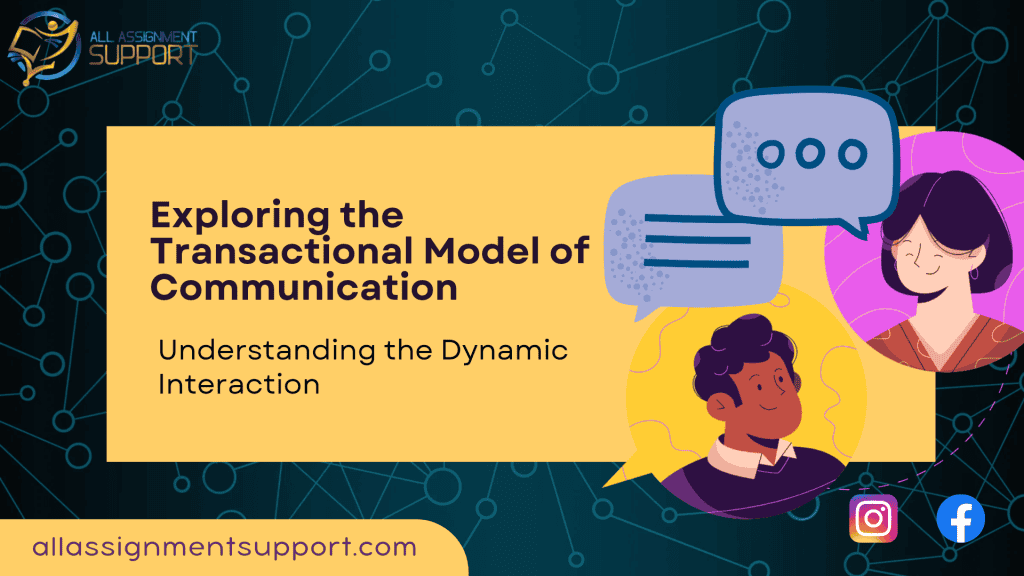Table of Contents
ToggleIntroduction- What is a Transactional Model Of Communication?
The Transactional Model of Communication, developed by Berglund and Shannon, portrays communication as a dynamic and simultaneous process. It views communication as a two-way exchange of messages between sender and receiver, where both parties actively encode and decode information. This bidirectional flow allows for real-time adjustments and feedback, enhancing understanding.
Contextual factors, such as culture and environment, influence communication, leading to more effective interactions. The model recognizes noise, which refers to any interference in the communication process, and encourages strategies to minimize its impact.
The Transactional Model applies to various communication settings, including interpersonal, group, and mass communication scenarios. Understanding this model enables individuals to engage in more meaningful and successful communication exchanges.
Therefore, the Transactional Model of Communication is a cornerstone in communication studies for explaining how people share ideas and information. Based on the idea of transactional communication, this paradigm departs from the conventional linear method by acknowledging communication as a dynamic, two-way process.
The Foundation of the Transactional Model
The Transactional Model of Communication owes its inception to the collaborative efforts of communication scholars Dean C. Barnlund and Claude E. Shannon. While Shannon, an engineer and mathematician, is renowned for his groundbreaking work in information theory, Barnlund contributed significantly to the field of communication studies. Their collaboration culminated in developing a revolutionary approach to understanding human communication.
Basic Premise of the Transactional Model
The fundamental notion that communication is a contemporary, two-way exchange rather than a unidirectional process is at the core of the transactional model. Traditional linear communication models assume that each participant plays either role independently since information moves in a one-sided direction from the sender to the receiver. The Transactional Model, however, suggests a more dynamic viewpoint.
In this transactional communication model, both parties involved, the sender and the receiver, are regarded as communicators simultaneously. Each person alternates between the roles of sender and receiver throughout the interaction. This mutual exchange emphasizes that communication is an ongoing process of encoding and decoding messages between participants rather than a one-off transmission.
Departure from Traditional Linear Models
The Transactional Model of Communication significantly departs from the traditional linear models that dominated communication theory for decades. Linear models portray communication as a linear process with a clear and singular flow of information from the sender to the receiver. The sender formulated the message, which was then encoded and transmitted through a channel to the receiver for decoding and interpretation.
In contrast, the Transactional Model challenges this simplistic view by acknowledging that communication is more complex and interactive. It recognizes that both the sender and receiver contribute to the meaning-making process. As communicators constantly exchange messages, feedback plays a crucial role in shaping and adjusting ongoing communication.
Advantages of Transactional Communication Models:
Here are the pertinent advantages of Transactional communicative models. Well, let’s have a run down into the same:
1. Emphasis on Interaction
Transactional communication models recognize the interactive nature of communication, where both participants are actively engaged as senders and receivers. This emphasis promotes more meaningful and dynamic exchanges.
2. Real-Time Adaptation
The bidirectional flow of communication allows participants to adjust their messages in real-time based on feedback, leading to enhanced clarity and understanding.
3. Contextual Understanding
Transactional models consider contextual factors, such as cultural and social influences, which helps communicators tailor their messages appropriately for different audiences.
4. Effective Feedback Loop
The continuous feedback loop in transactional communication facilitates better understanding and helps avoid misinterpretations or misunderstandings.
5. Relationship Building
Transactional models foster rapport and empathy by acknowledging the reciprocal nature of communication, strengthening interpersonal relationships.
6. Applicability in Various Settings
Transactional models are versatile and applicable in interpersonal, group, and mass communication scenarios, making them relevant for a wide range of contexts.
Read Also: The Role of Critical Thinking in Academic Writing
Disadvantages of Transactional Communication Models
While you had a look into some of the advantages out there, you have a couple of disadvantages too. Let us have a brief understanding on what these are:
1. Complexity
The dynamic nature of transactional models can make them more complex to understand and apply compared to linear communication models.
2. Difficulty in Feedback Interpretation
Interpreting feedback accurately can be challenging, as individuals may have different perspectives and reactions to messages.
3. Feedback Delay
In certain communication settings, such as mass communication or online interactions, feedback may be delayed or limited, making it harder to gauge audience responses.
4. Time-Consuming
The continuous exchange of messages in transactional models may require more time and effort to reach a consensus or make decisions, especially in group settings.
5. Possibility of Miscommunication
Communication is bidirectional, which makes it susceptible to misconceptions if the sender’s intentions are not clearly expressed or if the recipient reads the message incorrectly.
6. Cultural and Language Barriers
Cultural differences and language barriers may hinder effective communication, leading to semantic noise and misunderstandings.
Core Components of the Transactional Model
The Transactional Model of Communication comprises several core components that work together to facilitate effective communication between individuals. Understanding these components is vital for grasping the intricacies of this dynamic and interactive communication process.
1. Sender and Receiver: Roles and Message Exchange
According to the transactional model, both the sender and recipient actively participate in communication. The sender starts the engagement by creating a message to communicate facts, concepts, or feelings to the recipient. This message may be conveyed using spoken words, written material, gestures, or other nonverbal clues.
On the other hand, the receiver is in charge of deciphering the message and drawing meaning from the sender’s emotions. The act of decoding entails deciphering the symbols or signals the sender provides and giving them importance based on prior information, cultural context, and personal experiences.
The sender and receiver roles are not fixed but continuously alternate as the communication unfolds, making the process truly transactional. Each participant becomes both a sender and a receiver, contributing to the continuous flow of information in the interaction.
2. Encoding and Decoding: Influencing Understanding
The Transactional Model of Communication relies heavily on encoding and decoding. Encoding is the process through which a sender transforms their feelings, thoughts, or emotions into a message that the recipient can receive. The right language, tone, and nonverbal clues must be used for the desired meaning to be properly communicated.
Decoding, on the other hand, is the recipient’s interpretation of the sender’s message. During decoding, the receiver analyzes the symbols or signals in the message and assigns them meaning based on their comprehension and the surrounding circumstances.
Because every person contributes their particular viewpoints and experiences to the communication exchange, the encoding and decoding processes are not always the same, when the receiver’s interpretation differs from the sender’s intended meaning, miscommunication can result.
3. Feedback: The Key to Effective Communication
A crucial component of the Transactional Model of Communication is feedback. It describes the comments and reactions the recipient offers the sender upon receipt of the communication. Feedback, which can be vocal or nonverbal, is an essential way for the sender to evaluate the success of their communication.
The sender learns how the recipient sees and comprehends their communication through getting feedback. This information enables the sender to modify their communication approach, message, or delivery to improve clarity and guarantee that the message’s intended meaning is correctly communicated.
The transactional process has an ongoing, iterative feedback loop. The communication cycle continues when the sender reacts to the receiver’s comments, enhancing and developing the interaction.
Read Also: How to Stay Motivated When Working on Lengthy Assignments
Simultaneity and Transactional Communication
The Transactional Model of Communication incorporates the idea of simultaneity, highlighting that communication is a dynamic and simultaneous interaction between people rather than a sequential process. This particular feature of the model emphasizes the complex interactions between senders and receivers, resulting in a two-way exchange of information that changes the whole communication process.
● Simultaneous Communication
According to the transactional communication model, both parties participating in an encounter are simultaneously senders and receivers. As a result, the other person receives the message as the first person decodes it. As the dialogue progresses, the sender and receiver roles switch continually, allowing for real-time modifications and feedback.
The simultaneous communication in the transactional paradigm supports a more engaged and dynamic conversation than in traditional linear models, where information only travels in one direction. Each person actively contributes to creating meaning during a conversation by using verbal and nonverbal clues.
● Bidirectional Nature of Communication
The Transactional Model’s bidirectional character is a crucial component in which both parties impact one another’s responses and behaviour. The feedback and responses of the recipient influence how the sender continues their communication when messages are exchanged. In turn, the sender’s expressions—verbal or nonverbal—have an impact on the receiver’s comprehension and reactions.
This reciprocal influence makes communication a collaborative and co-creative process, where both individuals contribute to meaning-making and information exchange. The bidirectional nature allows for greater understanding, empathy, and responsiveness between communicators.
Examples of Simultaneous Communication in Everyday Conversations
Let us have an overview into the different forms of communication we have with our friends, family, business or office colleagues on a day-to-day basis. Helping you get a run-down into the same:
1. Face-to-Face Conversation
A face-to-face discussion involves two people who are actively communicating with one another. The other person listens as the first person speaks (the sender), understanding verbal signals, facial expressions, and body language (the receiver). Nonverbal cues from the recipient, such as nodding or keeping eye contact, give the sender feedback and persuade them to continue or modify their messages.
2. Phone Call
In a phone call, both parties are engaged in simultaneous communication. The person speaking (sender) conveys their thoughts and emotions, while the listener (receiver) interprets the words and tone to grasp the intended meaning. The receiver’s verbal responses or pauses serve as feedback for the sender, guiding the flow of conversation.
3. Group Discussion
In a group discussion, multiple participants communicate simultaneously, each acting as sender and receiver. As ideas and opinions are exchanged, each influences and responds to the contributions of others, fostering a collaborative and interactive conversation.
4. Online Chat
In digital communication, like online chatting, participants exchange messages in real-time, akin to a synchronous conversation. Each person can respond and provide feedback instantly, making it a dynamic and simultaneous communication experience.
Contextual Factors in the Transactional Model
The Transactional Model of Communication recognizes the critical role that the environment plays in influencing the course of communication. The terms “context” and “environment” are used to describe the context in which signals are transmitted, received, and processed. Understanding the context of communication exchanges is crucial for deciphering the genuine message and preventing misinterpretation.
1. Significance of Context in Communication
Contextual factors, such as cultural, social, and environmental elements, significantly impact how communication is perceived and understood. Different cultural backgrounds, social norms, and physical environments can lead to diverse interpretations of messages, leading to potential misunderstandings if not considered carefully.
2. Influence of Context on Message Interpretation
The context of communication impacts how the sender and the recipient understand communication. For instance, cultural quirks might affect the words, phrases, and gestures used in communication. What is deemed insulting or perplexing in one culture may be acceptable and reasonable in another.
Social factors, such as the relationship between communicators and their social roles, influence how messages are perceived. The same message delivered by a close friend might be interpreted differently when coming from a stranger or a supervisor.
Environmental factors, such as the physical setting of the communication, can impact the mood and atmosphere of the interaction. A noisy or distracting environment might hinder effective communication, while a quiet and conducive setting can enhance understanding.
Relevance of Understanding Context for Effective Communication
Understanding context is critical to achieving effective communication and avoiding misinterpretations. Here are some reasons why context matters:
1. Enhanced Clarity
Awareness of cultural and social context allows communicators to tailor their messages appropriately, ensuring they are clear and well-received by the intended audience.
2. Cultural Sensitivity
Understanding cultural differences fosters respect and sensitivity in communication, minimizing the risk of offending others inadvertently.
3. Improved Empathy
Recognizing the context enables communicators to empathize with the perspectives and emotions of others, leading to more compassionate and meaningful interactions.
4. Reduced Miscommunication
By considering contextual factors, communicators can anticipate potential misunderstandings and clarify any ambiguous points, reducing the chances of miscommunication.
5. Successful Negotiations
In professional settings, understanding the context can be vital for successful negotiations, as it helps identify shared interests and areas of compromise.
Noise and Interference in the Transactional Model
In the Transactional Model of communication, noise is any element that prevents the sender and receiver from smoothly exchanging messages. Noise can interfere with communication, resulting in misunderstandings, misinterpretations, or even total breakdowns. Promoting successful communication and guaranteeing the precise conveyance of messages requires understanding the many forms of noise and applying measures to combat them.
Definition of Noise in Communication
In the context of the Transactional Model, noise encompasses any external or internal interference that hinders the clear and accurate transmission of messages. Noise can occur at any stage of the communication process, affecting the encoding, transmission, reception, or decoding of the message.
Different Types of Noise and Their Impact
Do you want to know what are the different types of noises we hear at our surroundings? Helping you understand the prototypes involved here:
1. Physical Noise
Physical noise refers to external factors in the environment that disrupt communication. Examples include loud background noise, poor acoustics, or technical issues like static or poor signal quality during phone calls or video conferencing. Physical noise can lead to missed or misunderstood information, especially when participants struggle to hear or focus on the conversation.
2. Semantic Noise
Semantic noise presents difficulties with language and comprehension. It happens when jargon, language difficulties, or cultural differences cause the sender and the recipient to interpret words, phrases, or symbols differently. Semantic noise can cause confusion and misunderstanding because the message’s intended meaning may be lost in translation.
3. Psychological Noise
Psychological noise is internal interference that affects the cognitive processing of communication. It includes stress, preoccupation, personal biases, and emotional states. When individuals are emotionally agitated or distracted, their ability to receive and interpret messages accurately may be compromised, leading to distorted understanding.
Strategies to Overcome Noise and Improve Communication Clarity
Here are strategies connected with overcoming the noises that are surrounding you and thereby improving the overall clarity of communication. The list includes the following:
1. Active Listening
Engage in active listening by giving full attention to the speaker, focusing on the message, and avoiding distractions. This helps reduce the impact of physical and psychological noise.
2. Clarification and Repetition
Ask for clarification when unsure about the message’s meaning. Restate or paraphrase the message to ensure mutual understanding.
3. Cultural Sensitivity
Be aware of cultural differences in language and communication styles. Adapt communication to be more inclusive and respectful of diverse backgrounds.
4. Use Visual Aids
Utilize visual aids, such as charts, graphs, or images, to supplement verbal communication and enhance message comprehension.
5. Choose the Right Medium
Select the most appropriate communication medium based on the context and nature of the message. For complex or sensitive topics, opt for face-to-face communication to minimize semantic noise.
6. Check for Feedback
Encourage open feedback from the receiver to gauge their understanding and address any potential misunderstandings promptly.
Read Also: Why Academic Writing is Important for Your Career Success
Applications of the Transactional Model
The Transactional Model of Communication finds relevance in various communication settings, enabling a comprehensive understanding of human interaction. It applies to interpersonal, group, and mass communication, and offers valuable insights for analyzing communication dynamics in diverse scenarios, such as conflict resolution, public speaking, and advertising.
1. Interpersonal Communication
In interpersonal communication, the Transactional Model highlights the bidirectional nature of exchanges between two individuals. Both participants alternate between sender and receiver roles, continuously influencing each other’s responses and behaviours. Understanding the dynamic nature of communication aids in building rapport, active listening, and empathetic understanding in personal relationships.
Example: In a romantic relationship, both partners actively communicate their feelings, emotions, and needs (sender role) while being attentive to their partner’s responses and feedback (receiver role). The continuous exchange of messages shapes the dynamics of the relationship.
2. Group Communication
The Transactional Model is evident in group communication in team discussions, meetings, and collaborative projects. Multiple participants interact simultaneously, contributing as both senders and receivers. Recognizing the importance of feedback helps maintain a constructive and cohesive group dynamic.
Example: Each team member offers comments and insight as the group discusses ideas, exchanges information, and makes choices. Effective cooperation and problem-solving are fostered through two-way communication.
3. Mass Communication
In mass communication, the Transactional Model applies to interactions between a large sender (e.g., media, organizations) and a vast audience of receivers. Though the feedback loop is less direct, the audience’s response, or lack thereof, still influences future communication efforts.
Example: A television news broadcast disseminates information to millions of viewers, who may provide feedback through ratings, social media, or surveys. The response from the audience can shape the content and presentation of future broadcasts.
4. Conflict Resolution
The Transactional Model helps analyze communication dynamics during conflict resolution processes. It emphasizes the importance of active listening, empathetic understanding, and bidirectional influence between parties. Effective communication plays a pivotal role in reaching mutually beneficial solutions.
Example: In a workplace dispute, acknowledging the bidirectional nature of communication allows both parties to express their concerns (sender role) while actively listening to the other’s perspective (receiver role), fostering a collaborative resolution.
5. Public Speaking
When analyzing public speaking, the Transactional Model underscores the significance of feedback from the audience. Understanding the audience’s response guides the speaker’s delivery and aids in maintaining audience engagement.
Example: A motivational speaker delivering a speech gauges the audience’s reactions (feedback) through their expressions, nods, or applause. This feedback informs the speaker’s pacing, tone, and content to keep the audience engaged.
6. Advertising
The Transactional Model helps marketers understand the reciprocal relationship between advertisers and consumers in advertising. Advertisements are crafted to influence audience perceptions and behaviours, while consumer feedback informs future advertising strategies.
Example: An online retailer runs an advertising campaign, and based on consumer responses (e.g., clicks, conversions), they adjust the ad content or targeting to enhance its effectiveness.
Conclusion
The Transactional Model of Communication has versatile applications in various communication settings, from interpersonal interactions to mass communication. It provides a valuable framework for understanding the dynamic nature of human communication, emphasizing the bidirectional influence between communicators. Analyzing communication dynamics using this model aids in conflict resolution, public speaking, advertising, and other scenarios, enhancing overall communication effectiveness and fostering meaningful connections in diverse contexts.
The Transactional Model of Communication stands as a foundational framework for understanding the intricacies of human interaction across diverse communication settings. This dynamic and interactive model emphasizes the simultaneous roles of sender and receiver, where both participants engage in a bidirectional exchange of messages. The significance of context in shaping communication, the impact of noise on message clarity, and the importance of feedback in refining interactions are key takeaways from this model.
As we continue to engage in meaningful conversations in an interconnected world, the Transactional Model remains a valuable tool, empowering us to communicate more effectively, resolve conflicts harmoniously, and create impactful connections in both personal and professional realms.











